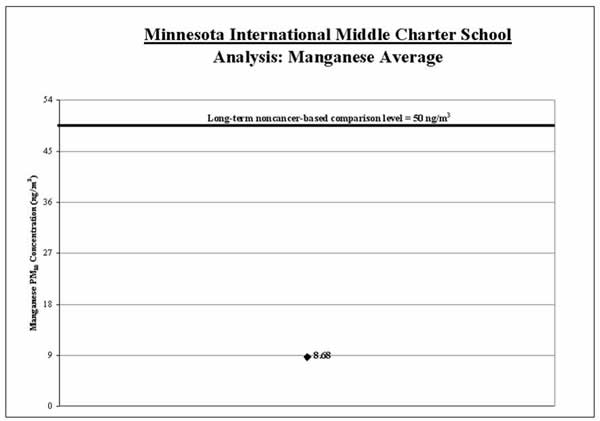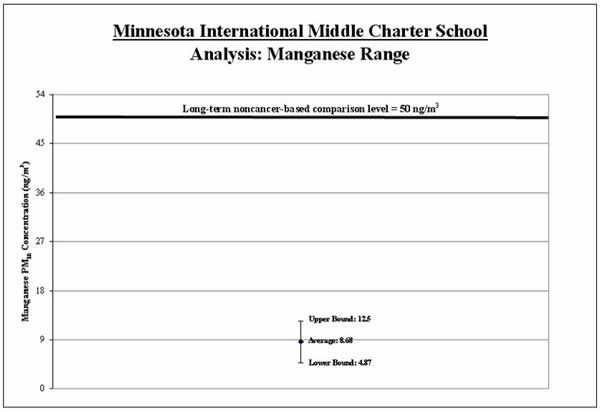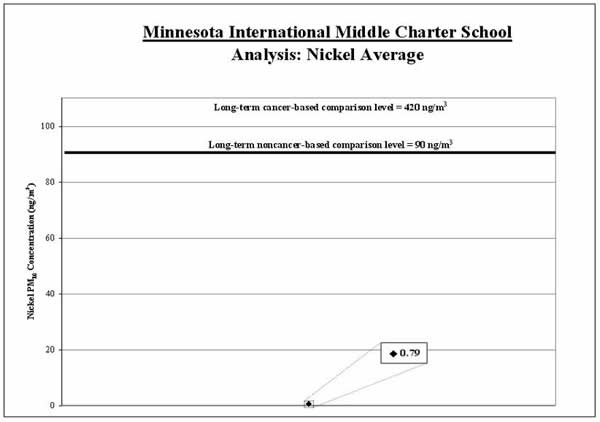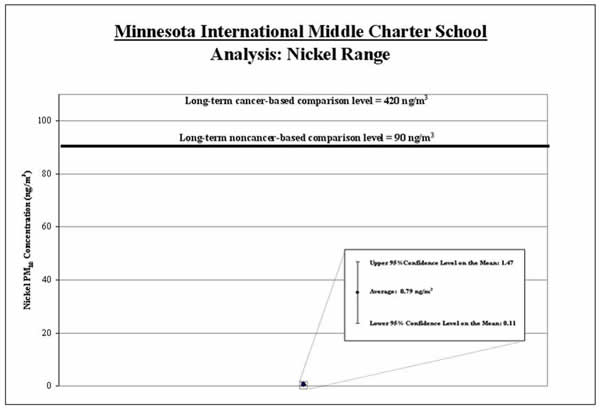Assessing Outdoor Air Near Schools
Minnesota International Middle Charter School - Minneapolis, MN
Results and Analysis of EPA’s monitoring
EPA selected this school for monitoring because it is located near a large municipal waste incinerator and a coatings manufacturing facility that emit air toxics. Computer models were used to determine which air toxics may be present at elevated levels in the outdoor air near the school. These models showed that hexavalent chromium, manganese, nickel, and three diisocyanate chemicals (hexamethylene-1,6-diisocyanate, 2,4-toluene diisocyanate, and methyl diphenyl diisocyanate) could be present in the air around the school and prompted EPA to test to see if the levels present may be of concern.
| Primary Findings | Levels of hexavalent chromium, manganese, and nickel in the air at the school were below levels of concern for short-term and long-term exposures. The monitors did not detect any diisocyanates. |
| Key Pollutants Monitored | Hexavalent chromium, nickel and diisocyanates (1,6-HDI, 2,4-TDI, and MDI). Inhalation may affect the respiratory system if people are exposed to high levels. Manganese. Inhalation may affect the nervous system if people are exposed to high levels. |
| Next Steps | EPA has decided to discontinue air toxics monitoring at Minnesota International Middle Charter School at this time because levels of hexavalent chromium, manganese, nickel, and diisocyanates in the air at the school are below levels of concern for long-term exposure to air toxics. The Minnesota Pollution Control Agency (MPCA) continues to oversee facilities in this area through several types of permits and voluntary programs. One of these permits, required by the Clean Air Act, outlines the legal emission control requirements industrial facilities must meet and must be renewed every five years, with opportunity for public comment. |
Summary of Study Approach and Findings
Approach:
- A monitor collected air samples from July 30 through October 10, 2009, at the Minnesota International Middle Charter School in Minnesota, MN. Hexavalent chromium, manganese, nickel, and diisocyanates (1,6-HDI, 2,4-TDI, and MDI) were the key pollutants of interest.
- We posted individual air sample results on this website throughout the monitoring period to keep your community informed during the monitoring period.
- During the monitoring period, we evaluated the monitored concentrations to see if there was a concern from short-term exposures (up to a couple of weeks).
- When the monitoring was complete we analyzed the results to see if there was a concern from long-term exposures (over a lifetime).
- Also, when the monitoring was complete, we evaluated all the air samples from the on-site monitor. We also evaluated information on wind speed and wind direction from a weather monitor at the school, along with historical weather information and information about nearby sources of hexavalent chromium, manganese, nickel, and diisocyanate emissions.
Findings:
- Based on the monitoring results, we found no concern for risk of health problems from short-term exposures to hexavalent chromium, manganese, nickel, and diisocyanates.
- Our analysis found that levels of hexavalent chromium, manganese, and nickel in the air at the school are below levels of concern for long-term exposure. We found there were no detectable levels of diisocyanates.
- The analysis indicates that hexavalent chromium, manganese, and nickel concentrations in the air near the school are influenced by nearby industrial facilities.
- The concentrations of hexavalent chromium, manganese, nickel and diisocyanates measured at the school are lower than those suggested by the information that helped identify this school for monitoring.
- The process to identify schools for monitoring relied on emissions estimates and other information. Ambient air monitoring at the school allowed measurement of what was actually in the air.
- The most recently available hexavalent chromium emissions estimates for the nearby facility from the 2005 EPA’s Toxics Release Inventory (TRI) arelower than the estimates used to identify this school for monitoring.
- The most recently available nickel emissions estimates for the nearby facility from 2005 TRI are slightly higher than the estimates used to identify this school for monitoring.
- There were no emission estimates of manganese, 1,6-HDI, 2,4-TDI, or MDI from the 2005 National Emission Inventory (NEI) or the 2005 and 2007 TRI.
- Because the analysis shows monitored concentrations of hexavalent chromium, manganese, and nickel to be below levels of concern, and because the monitors did not detect any diisocyanates, EPA has discontinued air toxics monitoring at Minnesota International Middle Charter School.
- Click here for additional information
How We Analyzed the Information We Collected at this School
The analysis considered whether the information collected at the school might raise concerns for the health of children or adults at the school. We looked at the following types of information:
- Measured hexavalent chromium, manganese, nickel, 1,6-HDI, 2,4-TDI, and MDI concentrations; and information on these pollutants
- Measured wind direction and wind speed at the school
- Information about nearby sources of hexavalent chromium, manganese, nickel, 1,6-HDI, 2,4-TDI, and MDI emissions
Analysis of Measured Manganese Concentrations:
1. Calculate the average: We calculated the average of the manganese measurements (shown by the black diamond in the graph below). We compared this average to the long-term comparison level (thick line on the graph below). The long-term comparison level represents the level of manganese in the air that is below levels associated with health concerns, even if someone breathed air containing manganese at that level all day, every day over a lifetime.
Result: The average manganese level for the samples collected was not above the long-term comparison level. The health concern is low.

2. Calculate a range: To account for varying air concentrations of manganese, we calculated a range around the average. We did this by estimating high and low values that the longer-term concentrations might reach using common statistical tools. We compared the highest point in the range (called the “upper bound”) to the long-term comparison level.
Result: The high end of the range is lower than the comparison level. The health concern is low.

Analysis of Measured Nickel Concentrations:
1. Calculate the average: We calculated the average of the nickel measurements (shown by the black diamond in the graph below). We compared this average to the long-term comparison levels (values at the top of the graph below).
Result: The average nickel level for the samples collected was not above the long-term comparison levels. The health concern is low.

2. Calculate a range: To account for varying air concentrations of nickel, we calculated a range around the average. We did this by estimating high and low values that the longer-term concentrations might reach using common statistical tools. We compared the highest point in the range (called the “upper bound”) to the long-term comparison levels.
Result: The high end of the range is lower than the comparison levels. The health concern is low.

Analysis of Measured Hexavalent Concentrations:
Result: Hexavalent chromium was detected in only five of thirteen samples, with concentrations ranging from 0.009 ng/m3 to 0.040 ng/m3. These concentrations are well below its cancer-based and noncancer-based comparison levels (8.3 ng/m3 and 100 ng/m3, respectively). Thus, the health concern is low.
Analysis of Measured Diisocyanates Concentrations:
Result: Hexamethylene-1,6-diisocyanate (1,6-HDI), 2,4-toluene diisocyanate (2,4-TDI), and methyl diphenyl diisocyanate (MDI) were not detected.
Analysis of Measured Wind Direction and Wind Speed at the School
We took measurements of wind direction and speed every day during the sample period. We took special note of the wind speed and direction on the days we took measurements of hexavalent chromium, manganese, nickel, and diisocyanates.
| What we looked at | What we found |
| We looked at whether the wind data taken on the days we took diisocyanate measurements are similar or different from the wind patterns during the entire monitoring period. | We found the wind patterns taken on the days we took diisocyanate measurements generally not similar to those observed during the entire monitoring period. |
| We looked at whether the wind pattern during the monitoring period is similar or different from wind patterns over the long term. | We do not have a full year of wind data at this school. However, based on wind data in the general region, we concluded that wind patterns over the sampling period were generally similar to the long-term patterns for the region. |
Analysis of Information on a Nearby Source of Hexavalent Chromium and Other Air Toxics Metals Emissions
| What we looked at | What we found |
| Whether we could determine if the sources were operating as usual during the monitoring period | The facility was operating normally during the monitoring period. |
| The concentrations of pollutants measured at the school are lower than those suggested by the information that helped identify this school for monitoring. | |
| The nearby source of hexavalent chromium and other air toxics emissions has operating permits issued by the State of Minnesota that include operating requirements. |
Analysis of Information on a Nearby Source of Diisocyanate Emissions
| What we looked at | What we found |
| Whether we could determine if the sources was operating as usual during the monitoring period | The facility was operating normally during the monitoring period. |
| There were no detections of any diisocyanate compounds. | |
| The nearby source of diisocyanate compounds has not had an operating permit since 2006 because the source’s potential emissions are below permitting thresholds. |
Additional Information
Technical Report for School: Assessing Outdoor Air Near Schools: Minnesota International Middle Charter School (Minneapolis, Minnesota) (PDF) (31pp, 200k). The technical report is geared toward risk assessors, risk managers, and other regulatory agencies.
Background on School Monitoring Effort
